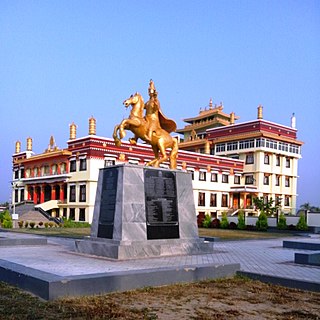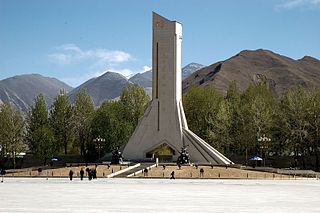Related Research Articles

The Tibet Autonomous Region, officially the Xizang Autonomous Region, often shortened to Tibet or Xizang, is an autonomous region of China and is part of Southwestern China.

Bhrikuti Devi (Sanskrit: भृकुटी, known to Tibetans as Bal-mo-bza' Khri-btsun, Bhelsa Tritsun, or simply, Khri bTsun was a princess of the Licchavi kingdom in Nepal. In c.622 Bhrikuti became the first wife and queen of the king of Tibet, Songtsen Gampo. Bhrikuti was seen as an incarnation of Green Tara, and is credited for bringing Buddhism to Tibet, together with the Jowo Mikyo Dorje statue for which the Jokhang Temple in Lhasa was built.

The Taipei Economic and Cultural Representative Office (TECRO), also known as Taipei Economic and Cultural Office (TECO), Taipei Representative Office (TRO) or Taipei Mission, is an alternative diplomatic institution serving as a de facto embassy or a consulate of the Republic of China to exercise the foreign affairs and consular services in specific countries which have established formal diplomatic relations with the People's Republic of China. The PRC denies the legitimacy of the ROC as a sovereign state and claims the ROC-controlled territories as an integral part of its territory. An exclusive mandate, namely One-China policy, requires that any country wishing to establish a diplomatic relationship with the PRC must first sever any formal relationship with the ROC. According to The Fletcher Forum of World Affairs, "non-recognition of the Taiwanese government is a prerequisite for conducting formal diplomatic relations with the PRC—in effect forcing other governments to choose between Beijing and Taipei." As a result, these countries only allow the ROC to establish representative offices instead of a fully-fledged embassy or consulate for the purpose of conducting practical bilateral relations without granting full diplomatic recognition.
The Tibetan sovereignty debate refers to two political debates. The first political debate is about whether or not the various territories which are within the People's Republic of China (PRC) that are claimed as political Tibet should separate themselves from China and become a new sovereign state. Many of the points in this political debate rest on the points which are within the second historical debate, about whether Tibet was independent or subordinate to China during certain periods of its recent history.
Tritsuk Detsen, better known by his nickname Ralpachen, was the 40th king of the Yarlung Dynasty of Tibet. He reigned after the death of his father, Sadnalegs, in c. 815, and grew the empire to its largest extent. He was murdered by his younger brother Langdarma in 838. Ralpachen is one of Tibet's three Dharma Kings, and referred to as "son of God" in the ancient Tibetan chronicle Testament of Ba.
Mangsong Mangtsen, Trimang Löntsen or Khri-mang-slon-rtsan succeeded to the Tibetan throne either after the death of his father Gungsong Gungtsen, or of his grandfather the 33rd Tibetan king Songtsen Gampo. He became the 34th king of Tibet's Yarlung Dynasty, and the second king during the Tibetan Empire era.
Tridu Songtsen, Tridu Songtsen or Dusong Mangban, was an emperor of the Tibetan Empire from 676 to 704.

The Mongolian and Tibetan Affairs Commission (MTAC) was a ministry-level commission of the Executive Yuan in the Republic of China. It was disbanded on 15 September 2017.

Tempa Tsering.
The Tibet Religious Foundation of His Holiness the Dalai Lama is one of the offices of the official representation of the 14th Dalai Lama and of the Tibetan government in exile, and a non-profit organization, founded in March 1997 and based in Taipei, Taiwan.

Elliot Sperling was one of the world's leading historians of Tibet and Tibetan-Chinese relations, and a MacArthur Fellow. He spent most of his scholarly career as an associate professor at Indiana University's Department of Central Eurasian Studies, with seven years as the department's chair.

The bilateral relations between India and Taiwan have improved since the 1990s, despite both nations not maintaining official diplomatic relations. India recognises only the People's Republic of China and not the Republic of China's claims of being the legitimate government of Mainland China, Hong Kong, and Macau - a conflict that emerged after the Chinese Civil War (1945–49). However, India's economic and commercial links as well as people-to-people contacts with Taiwan have expanded in recent years.
The Sumpa were a tribe living in northeastern Tibet from ancient times. Chinese historical sources refer to them as "Qiang", a term for people living in what is now southwest China, and their actual ethnic identity is not known. Their territory was absorbed by the Tibetan Empire in the late 7th century, after which point they gradually lost their independent identity.

The Tibetan diaspora are the diaspora of Tibetan people living outside Tibet.

The Monument to the Peaceful Liberation of Tibet stands in the southern part of the Potala square in Lhasa, Tibet Autonomous Region just outside the protective zone and buffer zone of the World Heritage Site. It celebrates what the People's Republic of China calls the Peaceful Liberation of Tibet by the People's Liberation Army, or what the exiled Tibetan government calls the invasion and annexation of Tibet. The foundation stone was laid on July 18, 2001 by Hu Jintao, China's vice-president at the time. The monument was unveiled on May 22, 2002.

The Ganden Phodrang or Ganden Podrang was the Tibetan system of government established by the 5th Dalai Lama in 1642, after the Oirat lord Güshi Khan who founded the Khoshut Khanate conferred all temporal power on the 5th Dalai Lama in a ceremony in Shigatse in the same year. Lhasa again became the capital of Tibet, and the Ganden Phodrang operated until the 1950s. The Ganden Phodrang accepted China's Qing emperors as overlords after the 1720 expedition, and the Qing became increasingly active in governing Tibet starting in the early 18th century. After the fall of the Qing empire in 1912, the Ganden Phodrang government lasted until the 1950s, when Tibet was annexed by the People's Republic of China. During most of the time from the early Qing period until the end of Ganden Phodrang rule, a governing council known as the Kashag operated as the highest authority in the Ganden Phodrang administration.
Lucette Boulnois (1931–2009) was a French historian of the Silk Road and trans-Himalayan trade. Her career was book-ended by her seminal 1963 book La route de la soie, which was translated into nine languages, and her 2001 elaboration on that work titled La route de la soie-dieux, guerriers et marchands. UNESCO described her as "a world-renowned authority on the history of the fabled trade route".
The Tibet Bureau in Paris, one of the offices of the official representation of the 14th Dalai Lama and of the Tibetan government in exile, is in charge of France, the Iberian Peninsula, the Maghreb and the Benelux countries. Founded in September 1992 it acts as an Embassy.

Tibet–India relations are said to have begun during the spread of Buddhism to Tibet from India during the 6th century AD. In 1959, the Dalai Lama fled to India after the failed 1959 Tibetan uprising. Since then, Tibetans-in-exile have been given asylum in India, with the Indian government accommodating them into 45 residential settlements across 10 states in the country, creating the Tibetan diaspora. From around 150,000 Tibetan refugees in 2011, the number fell to 85,000 in 2018, according to government data. Many Tibetans are now leaving India to go back to Tibet and other countries such as United States or Germany. The Government of India, soon after India's independence in 1947, treated Tibet as a de facto independent country. However, more recently India's policy on Tibet has been mindful of Chinese sensibilities, and has recognized Tibet as a part of China.
References
- ↑ DIIR, Offices of Tibet, Department of Information and International Relations
- ↑ Bureau du Tibet à Paris
- ↑ En bref, les droits de l'homme au Tibet Archived 2016-03-03 at the Wayback Machine , Bureau du Tibet de l'ONU, mars 2002.
- ↑ Loa Iok-sin, Tibetans confirm WikiLeak, Taipei Times, 25 December 2010